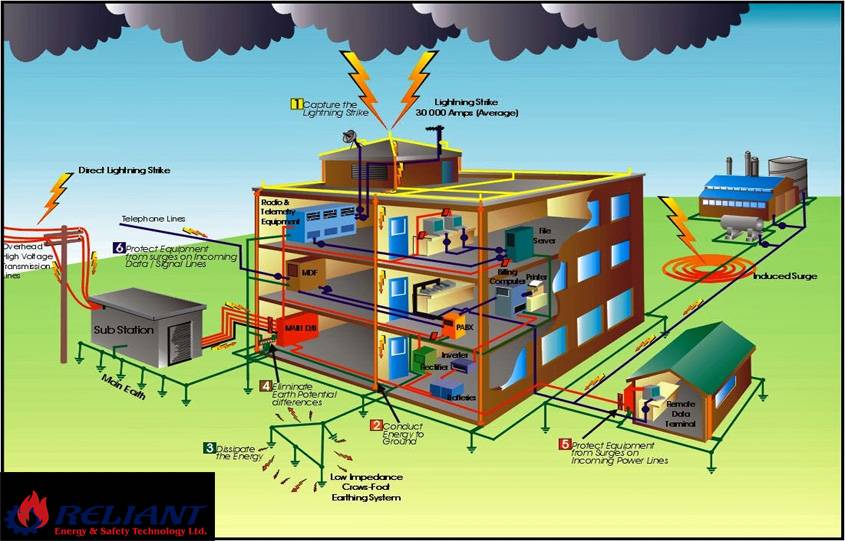Lightning is a powerful and unpredictable nature event that has both fascinated and scared people for hundreds of years. As it moves across the sky, it can release a force that can hurt people and damage things. This is why you need lightning protection devices. These clever devices are made to use and transfer lightning’s power, making them a key defense against its destructive effects.
Lightning protection devices use a mix of science and engineering to keep people and buildings safe from lightning strikes. They do this by giving lightning a good path to follow, which helps it get to the ground safely while reducing the risk of damage or harm. In this investigation, How lightning protection systems work? we’ll look into the basic ideas behind these systems and figure out how nature’s fury and human ingenuity work together to keep us safe during a thunderstorm.
Understanding Lightning Strikes
1. Formation of Lightning: Lightning is an electrical discharge that happens when there are too many electrical differences between a weather cloud and the ground or between the cloud and the ground. These imbalances happen because ice particles and water drops in the cloud rub against each other and bump into each other.
2. Types of Lightning: There are different kinds of lightning, such as cloud-to-ground (CG), cloud-to-cloud (CC), and intra-cloud (IC). CG lightning is the most dangerous because it hits the ground and puts buildings, trees, and people in danger.
3. Path of Least Resistance: Lightning travels along the road with the least amount of resistance. This is usually through the air, but it can also go through conductive materials like metal, water, and even the human body. Because of this, big buildings and things with sharp points are often hit.
4. Temperature and Speed: Lightning can hit temperatures of up to 50,000 degrees Fahrenheit (27,760 degrees Celsius) in a split second, which is hotter than the surface of the sun. It goes about 220,000 miles per hour (354,000 kilometers per hour), which is a very fast speed.
5.Thunder: The sound of thunder is made when the air around a lightning strike expands quickly. When lightning strikes, it heats the air so quickly that it sends out a shock wave, which we hear as a thunderclap.
6. Safety Measures: During a thunderstorm, people are told to stay inside to avoid getting struck by lightning. If you can’t stay inside, you should stay away from tall objects, open areas, and bodies of water. Wearing shoes with rubber soles and staying away from electrical materials can also lower the risk of getting hurt.
7. Lightning Protection Systems: Systems are put in place to protect houses and other structures from lightning. Lightning rods or air terminals are put on the highest points of the building and are linked to conductive cables that safely send the lightning’s energy to the ground. Grounding bars make sure that the electricity doesn’t hurt anyone.
8. Frequency and Geography: Lightning hits about 25 million times a year all over the world. People often call places where lightning hits often “lightning alleys,” and these places include parts of the United States, Africa, and South America.
9. Environmental Benefits: Even though it can cause damage, lightning is good for the environment in some ways. Lightning is part of the nitrogen cycle because it changes nitrogen in the air into chemicals that feed the soil. Also, lightning can help start wildfires, which are important for keeping some ecosystems alive.
In short, to understand lightning strikes, you need to know the science behind how they form, the different types of lightning, their incredible temperatures and speeds, and the safety measures and security systems that are in place to limit their destructive power. In places where lightning is common, it is very important to respect its power and know how to stay safe during hurricanes.
Components of a Lightning Protection System:
Lightning protection systems, which are also called lightning rods or lightning conductors, are made up of a few key parts that work together to safely direct lightning to the ground, away from buildings and people. Among these parts are:
1. Air Terminals (Lightning Rods): These are pointed metal rods or terminals that are strategically put on the highest points of a building. Their pointed shape makes it easier for the electric charge to ionize the air around them, which makes a path for the lightning to follow.
2. Conductors: These are the metal wires or rods that connect the air terminals to the grounding system. Lightning strikes are sent safely to the ground with the help of conductors.
3. Grounding System: The grounding system is made up of metal rods or plates that are buried and linked to the conductors. This method makes sure that the electricity from a lightning strike goes into the ground in a safe way.
4. Surge Arresters: These are devices that are put into the electrical system to protect against surges caused by lightning hits. They keep sensitive electronics from getting damaged by keeping too much electricity away from it.
How Lightning Protection Systems Work:
Lightning safety systems work on a simple principle: they give lightning a path with low resistance so that the electricity can safely flow to the ground. Here’s a description of how they work, step by step:
1. Detection: The lightning protection device is always on when a lightning storm is coming. Air stations are always keeping an eye on the electrical potential in the air.
2. Strike Diversion: When lightning is about to strike, the air terminal offers an attractive way for the lightning bolt. Ionization happens because of the pointed tip, and the electric charge follows the direction of the conductor.
3. Conduction: The lightning bolt moves down the wire and into the grounding system. Because the circuit has a lot of surface area, the electricity can flow through it safely.
4. Grounding: The lightning’s energy is sent harmlessly into the Earth by the grounding system. This keeps the building and its people safe.
5. Surge Protection: At the same time, surge arresters in the electrical system stop lightning from causing electrical surges that damage appliances, gadgets, and electrical circuits.
Why regular maintenance is important:
Lightning safety systems need to be maintained and checked regularly to make sure they keep working. Over time, the environment can damage or corrode system parts, making them less able to safely reroute lightning.
Conclusion
Lightning safety systems are an important way to protect against the damage that lightning can do. These systems protect buildings and the people inside them by giving lightning a path to follow and letting its energy go harmlessly into the ground. Regular upkeep is important to make sure they keep working and give you peace of mind during storms and protect your property from lightning damage.

